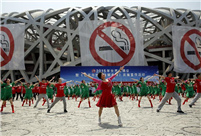

AN ARDUOUS TASK
Analysts have said that pollution controls are badly needed. After more than three decades of rapid economic growth, China's water pollution has become too serious to ignore.
Some 60 percent of ground water checked by 4,778 monitoring stations was rated as "bad" or "very bad," according to an MEP report released in June 2014.
It said 17 of 31 major freshwater lakes are moderately or slightly polluted, including China's two biggest lakes, Poyang and Dongting, both of which also have shrunk significantly compared with their peak.
The report also said that more than 300 of 657 cities sampled face water shortage problems.
In the Beijing-Tianjin-Hebei region, water per capita is even less than Israel, whose 300-cubic-meter standard is rated "extremely scarce."
As cities have expanded rapidly, even tap water has fallen victim to big polluters and mishandling of industrial chemicals. In recent years, panic buying of bottled water has occurred frequently in cities, where a rising middle class is increasingly concerned about water quality.
In 2013, Shanghai's drinking water came under threat after pig carcasses were found in the Huangpu River.
The Ministry of Supervision estimates that the number of people affected by substandard drinking water may be as high as 140 million.
The new action plan is part of China's efforts to wage war on all types of pollution. It follows a plan released in 2013 to tackle smog.
That plan seems to be working. The average reading of PM 2.5, airborne particles with a diameter small enough to penetrate the lungs, has declined more than 10 percent in Hebei and Tianjin while Beijing has had a 4-percent drop, according to figures from local governments.
HARSHER MEASURES WITH DEADLINES
Xia said one the strengths of the new action plan is that it defines the responsibilities of local governments.
Pollution checks will be conducted every year and the results will be part of performance reviews for provincial officials. Distribution of funds for the campaign will also depend on the results.
Meanwhile, the plan also targets businesses with concrete measures. From 2016, a blacklist will name businesses that exceed their pollutant quotas, with severe violators risking closure.
Li said concerns about their public image will pressure enterprises to make genuine efforts to reduce pollutants.
The action plan's other main strength is that it announces deadlines, according to analysts. The plan stipulates that more than 70 percent of water in the seven major river valleys, including the Yangtze and Yellow rivers, should be in good condition by 2020. It set the same target for offshore areas.
By the end of 2030, more than 75 percent of water in the seven major river valleys should be clear, with dark and odorous water in urban areas eliminated.
Li warned that national standards on water cleanliness have long existed without proper enforcement. With harsher rules in place, implementation is the key.
 |
 J-11 fighters in air exercise
J-11 fighters in air exercise Beauties dancing on the rings
Beauties dancing on the rings Attendants-to-be join Mr. & Miss Campus Contest
Attendants-to-be join Mr. & Miss Campus Contest Beijing's toughest anti-smoking law takes effect
Beijing's toughest anti-smoking law takes effect Family lives in cave for about 50 years in SW China
Family lives in cave for about 50 years in SW China PLA soldiers operating vehicle-mounted guns in drill
PLA soldiers operating vehicle-mounted guns in drill Blind carpenter in E China's Jiangxi
Blind carpenter in E China's Jiangxi China hosts overseas disaster relief exercise for the first time
China hosts overseas disaster relief exercise for the first time 20 pairs of twins who will become flight attendants in Sichuan
20 pairs of twins who will become flight attendants in Sichuan Obama is sowing discontent in S.China Sea
Obama is sowing discontent in S.China Sea Rescuers work through night to reach cruise ship survivors
Rescuers work through night to reach cruise ship survivors Driving through limbo
Driving through limbo Facing down MERS
Facing down MERSDay|Week